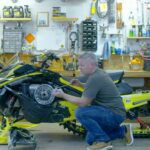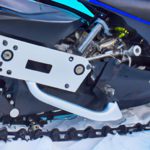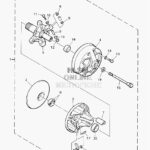Isn’t it frustrating when you’re all decked out in your winter gear, ready for a thrilling ride across the snow, only to find that your trusty snowmobile won’t budge? In the article “Why Does My Snowmobile Not Move?”, the potential reasons behind this annoying issue are thoroughly examined. From belt problems to issues with the drive chain, numerous elements could be sabotaging your much-anticipated alpine adventure. So sit back, relax, and let the troubleshooting commence.
Understanding the Snowmobile Structure
Before dwelling into the reasons of why your snowmobile may not move, it’s essential to understand the basic structure and operation of a snowmobile. Like any other vehicle or machinery, a snowmobile consists of several components, each with a unique part to play. In this section, we’ll dive into the basic structure of a snowmobile, its function and the importance of regular maintenance to ensure smooth operation and longevity of your snowy ride.
Parts of a Snowmobile
Your snowmobile is a complex machine made up of several parts, all intricately connected to give you a smooth, traction-filled ride over the snow. The essential parts include a fuel system, an engine, a drive belt, a drive chain, a track system, a brake system, control cables for throttle and braking, and an electrical system. Each of these components has a critical role to play, and if any one of them malfunctions, you could find your snowmobile not moving as it should.
How Snowmobiles Work
Although complex, the working of a snowmobile can be quite intriguing. Power from the engine is transferred to the drive belt, which engages the drive chain. Spurred by this chain, the track system propels the snowmobile forward. The throttle and control cables affect speed and direction, while the brakes, naturally, help you stop. The electrical system powers the snowmobile’s lights, ignition system, and other functions.
Importance of Regular Maintenance
Now that you understand how a snowmobile works, you’ll appreciate why it’s so critical to keep all its parts in tip-top condition. Regularly inspecting and servicing your snowmobile ensures that it’s always ready to ride when you are. Plus, it lengthens the life of your snowmobile and saves you money in the long run, as you can prevent minor issues from escalating into major, more expensive problems.
Fuel-Based Problems
Fuel problems are one of the most common reasons your snowmobile may not move. Let’s delve into fuel-related issues that could be the culprit.
Lack of Fuel
Though it might sound apparent, running out of fuel is a common reason why a snowmobile doesn’t move. Always ensure you have enough fuel before setting off.
Use of Improper Fuel
Different snowmobiles require different types of fuel. Using the wrong fuel type can cause problems with starting and running the machine. Make sure you’re using the right fuel for your specific snowmobile.
Clogged Fuel Injectors
The fuel injector’s job is to spray a precise amount of fuel into the engine. A clogged fuel injector disturbs this process, potentially causing your snowmobile to stall or not move.
Deposits in Fuel Tank
Over time, deposits can form in the fuel tank, leading to potential blockages in the fuel lines. It’s important to clean your fuel tank regularly to prevent such problems.
Issues with the Engine
The engine is the heart of your snowmobile. Any issues here could be catastrophic.
Engine Fails to Start
This could be due to a variety of reasons, such as a dead battery, faulty spark plugs, or air in the fuel line.
Overheating Engine
Although snowmobiles are designed to run in cold temperatures, they can overheat. This could result from several factors, such as a blocked cooling system or low coolant levels.
Blocking in Exhaust or Intake System
Blockage in the exhaust system could cause a buildup of dangerous gases or cause your engine to overheat. In the intake system, it could prevent your engine from getting the air it needs to run.
Problems in the Drive Belt
The drive belt is a vital part of the snowmobile that transfers power from the engine to the tracks. Drive belt problems might prevent your snowmobile from moving.
Worn Out Drive Belt
A worn-out drive belt might slip or not transfer enough power for your snowmobile to move.
Incorrectly Installed Drive Belt
An improperly installed drive belt can negatively impact your snowmobile’s performance and might even break.
Drive Belt Quality Issues
Like any other part of your snowmobile, using poor quality or wrong type of drive belt could lead to failure. It’s crucial to choose high-quality, suitable drive belts for your snowmobile.
Issues with the Drive Chain
The drive chain transfers power from the drive belt to the track system. Without it, your snowmobile won’t move.
Excessive Slack in the Drive Chain
Too much slack in the drive chain makes it less effective at transmitting power from the drive belt to the track system.
Rusted or Broken Drive Chain
A rusted or broken chain is incapable of transmitting power, leaving your snowmobile immobile.
Problems in the Track System
The track system is responsible for moving your snowmobile over the snow. Issues here could cause your snowmobile not to move.
Frozen Tracks
If your tracks are frozen, they’ll be unable to rotate, leaving your snowmobile stuck.
Dried Out and Cracked Tracks
Just like any rubber-based product, your snowmobile’s tracks can dry out and crack over time or in extreme cold. This can cause slipping or, in extreme cases, the track to break.
Misaligned Tracks
Improperly aligned tracks can cause issues with turning and might even break under strain.
Brake-Related Problems
If your brakes aren’t working correctly, the snowmobile can seize up and not move.
Damaged Brake Band
A damaged brake band can cause unintentional braking or prevent the snowmobile from moving.
Blocked Brake Fluid Line
A clogged brake fluid line can also cause the brakes to engage unintentionally.
Worn Out Brake Pads
Like any other vehicle, worn-out brake pads can cause braking issues. Though less likely, worn-out brake pads could also affect your snowmobile’s movement.
Throttle and Control Cables Issues
These crucial cables control your speed and steering. Any problem with these can impact your snowmobile’s functionality.
Frozen Throttle Cable
Cold and moisture can freeze your throttle cable, preventing you from controlling your snowmobile’s speed.
Loose Control Cables
Loose control cables can make your snowmobile hard to steer, causing unsafe riding conditions.
Electrical System Failures
Finally, the electrical system of your snowmobile is responsible for various tasks and can impact the ability of your snowmobile to move.
Faulty Ignition System
A faulty ignition system can mean that your engine won’t start, keeping your snowmobile stationary.
Dead Battery
Without a functional battery, your snowmobile’s electrical system won’t work, and neither will your snowmobile.
Problems with Wiring or Fuses
Faulty wiring or blown fuses can cause a range of issues, from difficulties starting your snowmobile to problems with the lights or other electrical systems.
Proactive Measures to Prevent Snowmobile Problems
As significant as it is to understand specific issues, it’s equally essential to take some measures to prevent snowmobile problems in the first place.
Regular Inspection and Maintenance
Regularly inspect and maintain your snowmobile to keep it in top condition.
Proper Storage of Snowmobiles
Storing your snowmobile properly when not in use can prevent issues like rusted chains, dried out tracks, or frozen cables.
Understanding Common Symptoms and Troubleshooting
Many common problems are associated with specific symptoms. Getting to know those symptoms can help you diagnose and potentially fix the issue without professional help.
By understanding the structure of your snowmobile, you can pinpoint the exact problem. Remember to always follow the manufacturer’s guidelines for maintenance and troubleshooting for ultimate snowmobile performance.
- What Snowboard Bindings Should I Get? - January 23, 2024
- What Size Screws For Snowboard Bindings? - January 23, 2024
- How To Snowmobile On Water? - January 23, 2024










